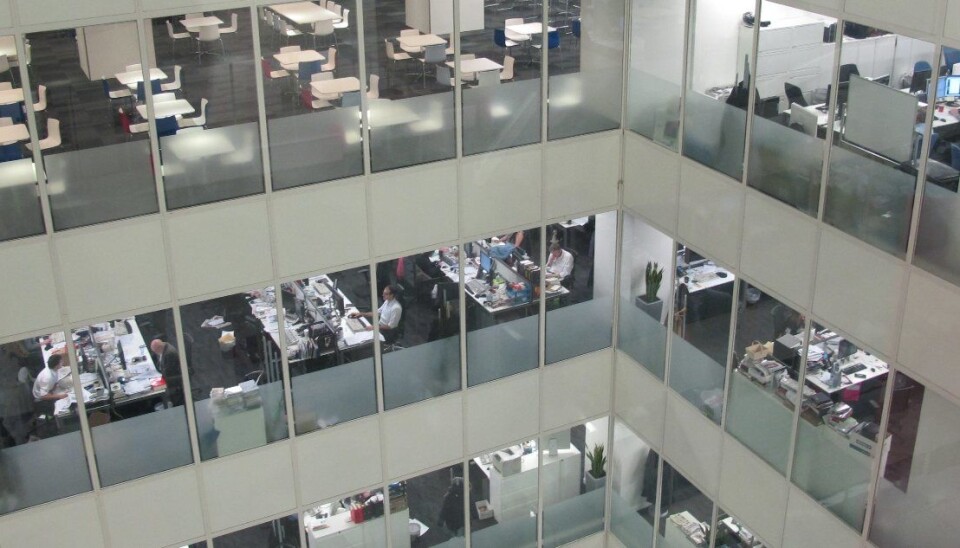
Costly cacophony in open plan offices
Noisy office landscapes increase fatigue and drain motivation from employees. In Sweden alone the result may cost companies more than €240 million a year.
Separate offices are out, open landscapes are in. When companies choose to refurbish their offices or design new workplaces, they often choose an open landscape as a way to promote teamwork and interaction. And of course it’s cheaper, because more people can be crammed into a smaller space.
If you’ve worked in this sort of landscape you're familiar with the disadvantages: Co-workers shout to each other over dividers rather than walking over to talk. Printers and copiers run continuously in an easily accessible -- but all too audible -- spot. Phones ring, the coffee machine gasps and sighs. It's office cacophony.
We might think that we can handle the aural assault -- but a Swedish doctoral thesis now suggests we don't work well in this kind of noisy environment.
If your job demands concentration, or learning and remembering new information, your efficiency can drop by as much as ten percent if you can hear people talking around you.

A conservative estimate of the losses in productivity for Swedish businesses is more than SEK two billion a year, or about €240 million.
Intelligible speech worse than a low rumble
Helena Jahncke, an environmental psychologist, used four different studies to examine how noise affects employees. One of her studies involved asking participants to attempt typical tasks for an office worker while being exposed to different levels of background noise.
In one test, participants were asked to use several different tables of figures to find a residence built after 1963 that cost more than €57,000 and that had a floor space of less than 63m2.
Assignments like this, where you need to remember variables and use them to find the correct information, were among the hardest for participants working in noisy landscape.
“We’ve seen that a worker’s performance declines by two to ten percent when what colleagues are saying in the background is intelligible, as compared to when only a general hubbub of voices can be heard,” Jahncke said.
90,000 Norwegian work hours lost
Jahncke has devised a simple equation to assess the costs of noise to Swedish enterprises: Assuming a company has 110 office employees with an average salary of €3,000 a month, the cost of a two percent reduction in efficiency adds up to €100,000 annually, if the employers’ social security contributions are included in the calculation.
About 230,000 Swedes work in open plan offices, meaning the total loss for Swedish workplaces runs to at least €240 million.
Norwegian statistics don’t say what kind of office layouts people work in. But it’s reasonable to assume that the percentage of office landscapes is comparable to that across the border in Sweden.
That puts the Norwegian population of open plan office workers at 120,000.
With Norway’s work week of 37.5 hours and a two percent drop in effectiveness per person, this means 90,000 wasted work hours per week.
More fatigue, less motivation
“This is just an estimate based on average figures,” Jahncke stressed.
“But we’ve seen that performance can decline by two to ten percent, so you could say we’re using the lowest estimate in this calculation. The costs would be higher for demanding work tasks requiring greater thought.” Jahncke’s studies show that people tired more easily and became less motivated in noisy surroundings.
The researcher points out that one result may be additional sick leave, although these costs have not been included in her calculations.
Soundproofing can make talking worse
Office managers are all too familiar with complaints about noise in open plan offices. Many have tried to lower the volume with various types of soundproofing materials on the ceiling and dividers between desks or work clusters.
But these can actually exacerbate the problem, Jahncke says.
“Intelligible speech − understanding what your co-workers are saying − is the most distracting noise for employees. Unfortunately, if you lower background noise you might make nearby conversations come through better. That can make these remedies counterproductive,” she says.
“It can be hard to find the proper balance between lowering the general sound level and lowering the levels of co-workers' intelligible speech.”
Earplugs an option
Nevertheless, solutions to the noise problem in open plan offices are available. Special closed offices can be offered to individuals who need to concentrate, or there can be rooms for staff to take a break in relative solitude.
Or there’s the cheaper method of providing staff with earplugs when noise levels are unmanageable.
However, Jahncke says it can be more effective to start from scratch.
“You need to design offices from the very start in accordance with what kind of work people actually do,” she says.
----------------------
Read the Norwegian version of this article at forskning.no
Translated by: Glenn Ostling








